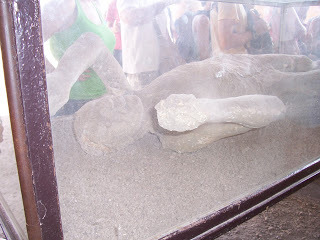The Roots of Rome: Lessons from the Gardens of Pompeii

It is widely known that the ruins of Pompeii contain plaster casts of humans that perished in the 79 AD eruption of Mount Vesuvius. These unfortunate souls were buried alive as ash from the eruption piled upon them. Centuries later, their bodies had decayed, leaving perfectly molded cavities in the hardened ash. After the rediscovery of Pompeii in the 1700s, the cavities were filled in with plaster, and the exact deaths of citizens of Pompeii were thus immaculately reconstructed.
It is far less well known that the same was done with the root systems of ancient Roman plants and trees. Mount Vesuvius erupted in August, and many species of plant life abundant in Pompeii's gardens were in full bloom. The reconstruction of their root systems, in combination with other data, has led us today to a strong understanding of these gardens.
 House of the Faun floor plan with garden at rightAnd some of these gardens were huge. At the House of the Faun, one of the largest villas in all of Pompeii, occupying an entire city block, two enormous gardens were present. The larger of the two was approximately 15,000 square feet. Within it were plants for food, for beauty, for scent, for wine, and for medicine.
House of the Faun floor plan with garden at rightAnd some of these gardens were huge. At the House of the Faun, one of the largest villas in all of Pompeii, occupying an entire city block, two enormous gardens were present. The larger of the two was approximately 15,000 square feet. Within it were plants for food, for beauty, for scent, for wine, and for medicine.Much of the knowledge of agriculture in ancient Rome had come from Egypt. At the time of the eruption of Mount Vesuvius in what is now Campania, Italy, the Egyptians had been farming commercially for centuries. One of the responsibilities of the pharaohs was the determination of what crops would be planted by whom and when.
The Romans began to mimic this system. According to Diane E.E. Kleiner in her book, Cleopatra and Rome,
Caesar and Cicero and other wealthy Republican patrons also vied with one another to see who could have the largest and most magnificent Egyptian-style garden. The goal was to create a complete setting that conjured up the Nile or some other exotic body of water.And Julius Caesar himself has been quoted as saying, "There is nothing I would rather know than the causes of the river which lie hidden through so many ages and its unknown source." Of course, he was referring to the river Nile.
This blog post explores a non-fictional theme or locale that is incorporated in The Vesuvius Isotope, a novel by Kristen Elise. Order your copy of The Vesuvius Isotope on Amazon (print or Kindle version,) BarnesandNoble.com (print or Nook version,) Kobo.com (Kobo version,) or iBookstore (iBooks version.) Or purchase a SIGNED copy at www.kristenelisephd.com.
Published on July 22, 2013 10:53
No comments have been added yet.



